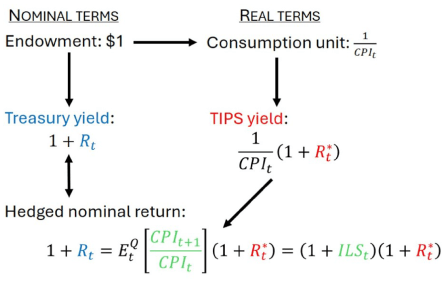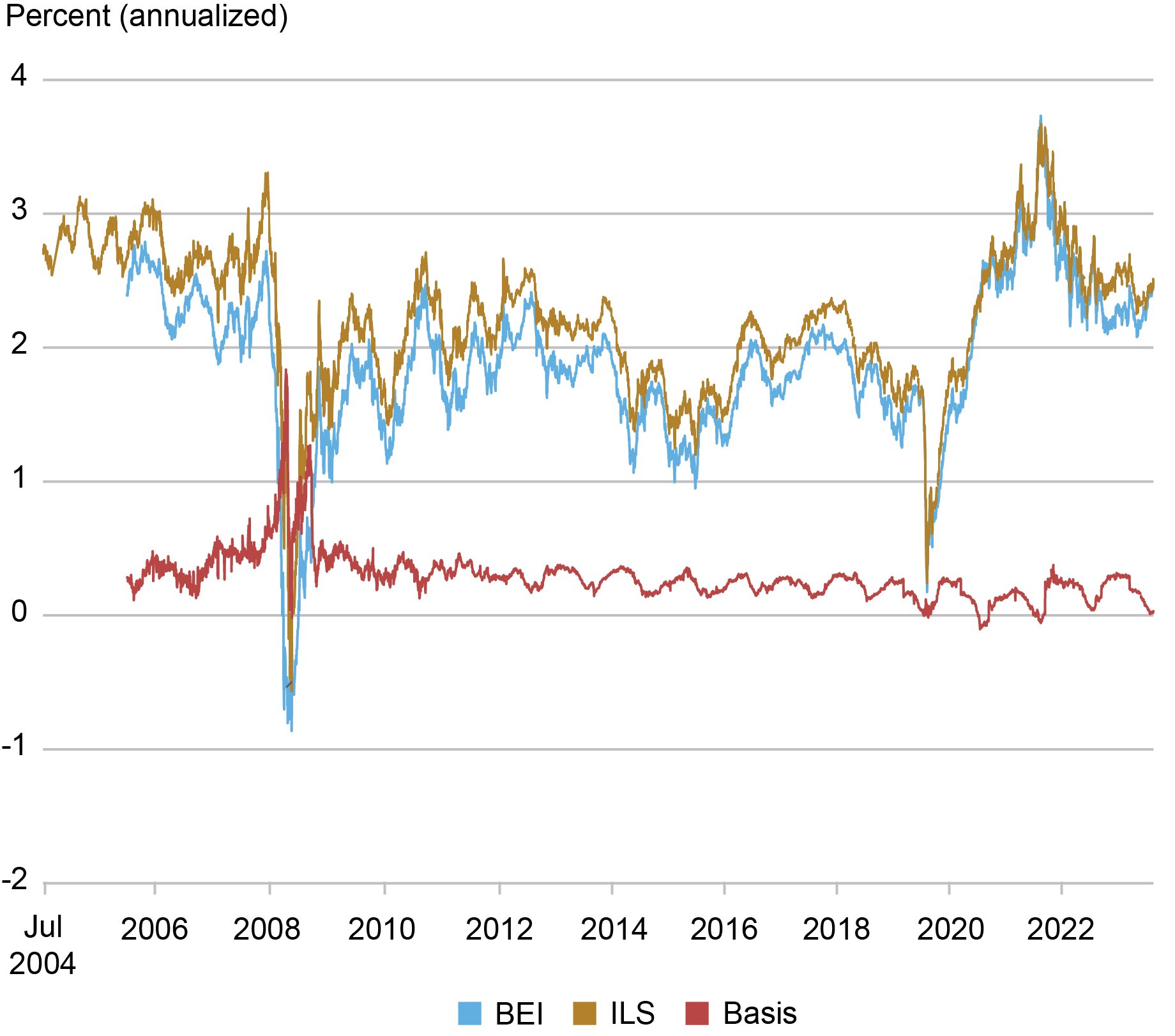

Because the late Nineteen Nineties, the U.S. Treasury has issued debt in two principal kinds: nominal bonds, which give fixed-cash scheduled funds, and Treasury Inflation Protected Securities—or TIPS—which give the holder with inflation-protected funds that rise with U.S. inflation. On the coronary heart of their relative valuation lie market contributors’ expectations of future inflation, an object of curiosity for teachers, policymakers, and buyers alike. After briefly reviewing the theoretical and empirical hyperlinks between TIPS and Treasury yields, this put up, primarily based on a current analysis paper, explores whether or not market perceptions of U.S. sovereign credit score danger may help clarify the relative valuation of those monetary devices.
An Obvious Arbitrage on the Treasury Market
Monetary intermediaries enter lengthy and brief positions on each nominal and inflation-protected Treasuries, which they usually hedge with inflation-linked swaps (ILS). No-arbitrage principle implies that it ought to be equal to purchase a TIPS or to assemble an artificial place by shopping for a nominal Treasury invoice and an inflation swap, such that the mounted cashflow is changed by an inflation-adjusted one. Subsequently, in precept, the ILS charge ought to be precisely equal to the so-called breakeven inflation charge (BEI)—the unfold between the yield of a nominal Treasury and that of a TIPS of similar maturity (see the instance described within the determine under).
The Inflation-Linked Swap Charge Is Linked to the Nominal and TIPS Charge by No-Arbitrage

In follow, the ILS has virtually at all times been larger than the BEI, as proven within the chart under. The ensuing inflation foundation has averaged roughly 30 foundation factors since 2004, an anomaly that has been referred to as the TIPS-Treasury bond valuation puzzle.
5-12 months Inflation Swap Charge Constantly Exceeds 5-12 months Breakeven Inflation Charge

Supply: Bloomberg L.P.
Notes: The blue line exhibits the five-year maturity breakeven inflation charge (BEI), outlined because the unfold between a five-year nominal Treasury yield and a five-year TIPS yield. The gold line is the speed of a five-year zero-coupon inflation-linked swap (ILS). The pink line is the idea, i.e., the unfold between the ILS and the BEI.
Current explanations of the inflation foundation have centered on limits to arbitrage, and on options and frictions of the TIPS market, whereby the TIPS’ relative cheapness is defined by its poorer liquidity. As an alternative, we focus under on the potential of sovereign credit score danger to differentially have an effect on Treasury yields and ILS- and TIPS-based inflation compensation.
There Are No Excellent Measures of Sovereign Credit score Threat
Sovereign credit score danger could be broadly outlined because the chance of observing a credit score occasion, which, based on the Worldwide Swaps and Derivatives Affiliation, is every time a authorities both (1) fails to repay, (2) repudiates or imposes a moratorium, or (3) restructures any of its borrowed cash of any quantity.
To evaluate the publicity of nominal Treasuries, TIPS, and ILS to sovereign credit score danger, we have to discover an indicator of the latter that strikes sufficiently over time, thereby excluding credit score scores, which change occasionally. Since our estimates depend on linear regressions, it’s adequate that the indicator correlates with sovereign credit score danger, nevertheless it doesn’t have to be good.
Our analysis depends on two proxies which have been used extensively within the educational literature. First, Reinhart and Rogoff (2010) recommend that the ratio of a rustic’s excellent debt to GDP is a non-market measure of its fiscal well being. Second, researchers have used the premium paid on U.S. sovereign credit score default swaps (CDS). These are insurance coverage merchandise that give purchasers compensation for bond losses that happen as a result of a U.S. credit score occasion in trade for a hard and fast premium paid each quarter. Not too long ago, nevertheless, the reliability of CDS premia as a sovereign credit score danger indicator has been questioned: The amount of excellent contracts has decreased sharply during the last decade—as demonstrated by Boyarchenko and Shachar (2020)—and the obtainable information displays quoted CDS spreads slightly than precise traded spreads.
We discover that each proxies are considerably and positively correlated with the inflation foundation, above and past the a part of the unfold that’s defined by TIPS liquidity and limits to arbitrage. To higher perceive why the unfold is widening, we carry out regressions on the person elements of the unfold—i.e., the ILS, the nominal Treasury yield, and the TIPS yield—individually. Surprisingly, each the ILS and the nominal Treasury yield correlate negatively with the credit score danger proxies, whereas the TIPS correlates positively, if something.
Our empirical estimates are onerous to reconcile with financial instinct. The nominal Treasury yield could be anticipated to have a optimistic correlation with sovereign credit score danger since a U.S. credit score occasion would possible result in a loss for bondholders. In the identical vein, since ILS are collateralized, we might count on their publicity to credit score danger to be minimal slightly than unfavourable.
A Idea of Differential Publicity by Inflation Dynamics
What forces may clarify our outcomes? We first rule out the likelihood that the market believes in a selective compensation of nominal Treasuries versus TIPS, the place the latter would undergo extra by, for instance, the cancellation of inflation indexation. Intuitively, such a channel can not rationalize the unfavourable obvious publicity of nominal Treasuries and ILS to credit score occasions.
Alternatively, the existence of an interconnection between inflation and the perceived chance of sovereign credit score occasions can clarify our empirical patterns. We establish two essential relationships. First, the ILS unfavourable correlation with sovereign credit score danger could be rationalized if anticipated inflation decreases when market views of sovereign creditworthiness deteriorate. This was notably the case following the 2008 monetary disaster within the U.S., when a drop in realized inflation and inflation expectations coincided with the next sovereign credit score danger. This channel impacts each the ILS and the nominal Treasury in the identical method since they each require a compensation for inflation.
Second, the bigger unfavourable publicity of the nominal Treasury yield turns into believable if we assume that realized inflation would leap upon the set off of a credit score occasion. Whereas hyperinflation within the wake of a default isn’t unusual in rising international locations, this assumption is very speculative within the case of the U.S. since no such episode has arisen within the U.S. in virtually 100 years.
This second channel provides an extra unfavourable publicity to the nominal credit score unfold. To know, think about {that a} nation’s value index jumps after a credit score occasion has been noticed. The true worth of all nominal securities excellent, regardless of their defaultable nature, declines considerably. In different phrases, any promised money fee buys much less of a consumption basket. In consequence, the nominal credit score unfold decreases because the chance of a sovereign credit score occasion will increase.
In distinction, TIPS are nearly unaffected by inflation dynamics provided that their money flows are in actual phrases. Nevertheless, a credit score occasion may result in investor losses, as with nominal Treasuries, due to potential failure by the federal government to repay fully its promised liabilities. TIPS publicity to credit score danger is thus, if something, optimistic.
Intricate Joint Dynamics of Inflation and Sovereign Credit score Threat Are Supported Empirically
We assess the empirical plausibility of our theoretical channels by estimating an asset pricing mannequin geared toward collectively becoming the time period construction of ILS charges, nominal Treasury and TIPS yields, and CDS spreads. Our framework encompasses the potential of sovereign credit score occasions triggering CDS funds, in addition to free correlations between anticipated inflation and sovereign credit score danger and between realized inflation and credit score occasions. We additionally embed liquidity drivers of TIPS and CDS to seize various doable explanations of the inflation foundation.
Our estimates present assist for each interactions between inflation and credit score occasion dynamics. We discover that, on common, the inflation response to a credit score occasion could be the most important driver of the inflation foundation. Our framework additionally permits for a time collection decomposition of the significance of sovereign credit score danger in explaining the inflation foundation. We present that credit score danger issues develop with a lag after 2008, such that the spike noticed within the chart above is usually as a result of poor TIPS liquidity, in keeping with earlier findings. Submit-2009 dynamics are, nevertheless, dominated by sovereign credit score danger issues, in keeping with our principle.

Guillaume Roussellet is a analysis economist in Macrofinance Research within the Federal Reserve Financial institution of New York’s Analysis and Statistics Group.
Methods to cite this put up:
Guillaume Roussellet, “Exploring the TIPS‑Treasury Valuation Puzzle,” Federal Reserve Financial institution of New York Liberty Road Economics, July 1, 2024, https://libertystreeteconomics.newyorkfed.org/2024/07/exploring-the-tips-treasury-valuation-puzzle/.
Disclaimer
The views expressed on this put up are these of the writer(s) and don’t essentially mirror the place of the Federal Reserve Financial institution of New York or the Federal Reserve System. Any errors or omissions are the accountability of the writer(s).